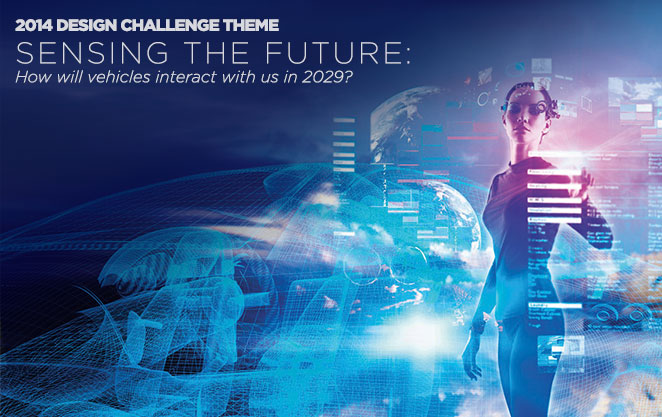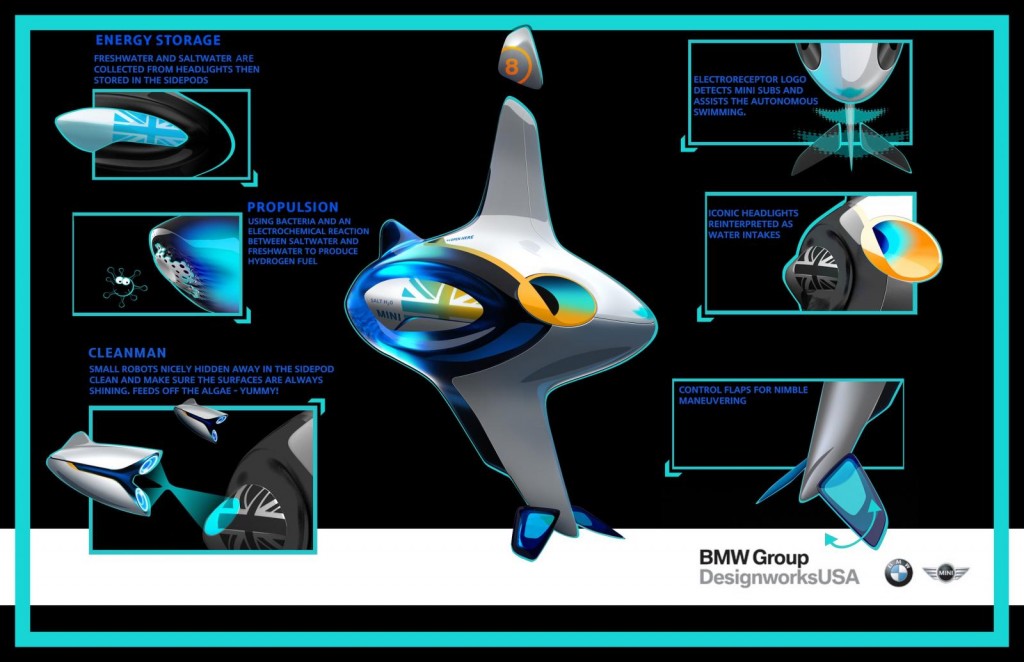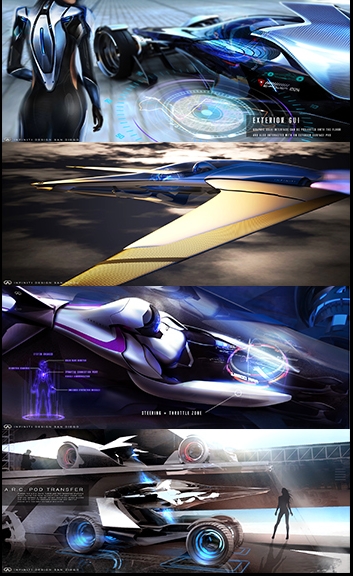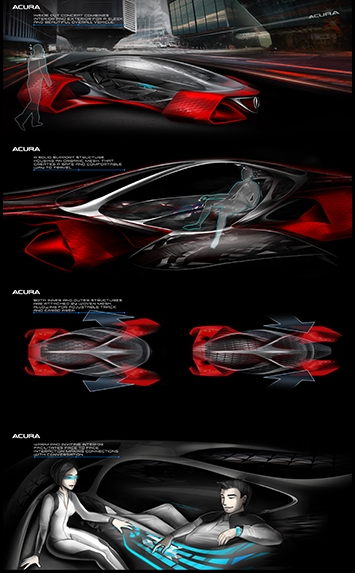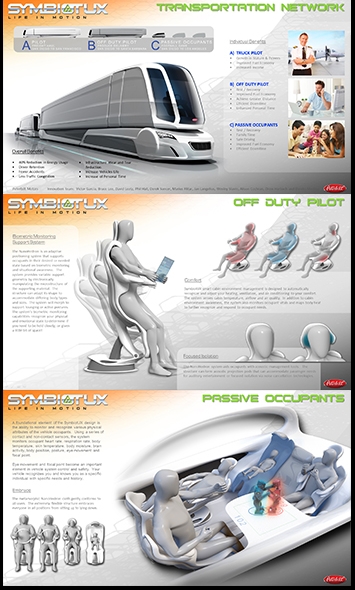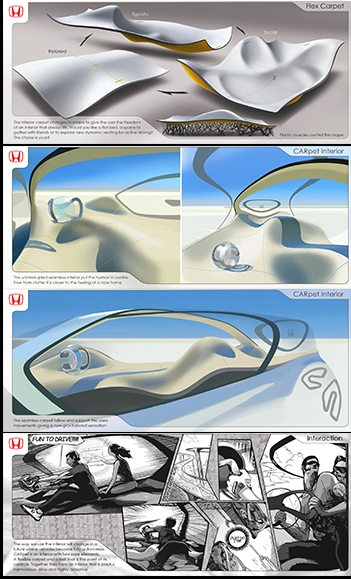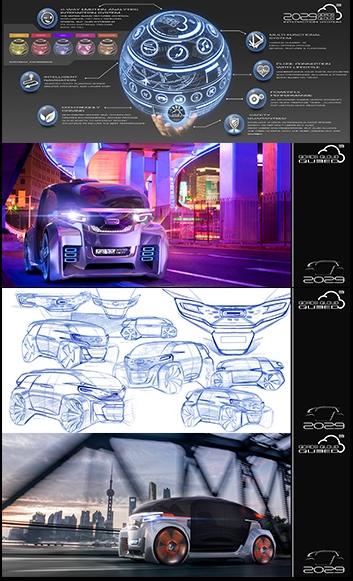How far we could get in the next 15 years? The Los Angeles Auto Show (LA Auto Show) has unveiled the 2014 Design Challenge entries submitted by world-renowned auto design studios for its 11th annual competition. This year’s entries explore the future of automobile connectivity by responding to the prompt: “Sensing the Future: How Will Cars Interact With Us In 2029?”
Each Design Challenge entry showcases how future technology will further transform human-to-machine interfaces that connect with senses, predict our next moves and create a more humanlike relationship with our vehicles. Specifically, entries are focused on automotive interiors that will comfortably and safely connect the driver and/or passengers to the car by 2029.
The 2014 LA Auto Show Design Challenge Entries:
Infiniti Design San Diego (USA) introduces a brand new universal fuselage pod that can transform into three vehicle types. This vehicle will be used for the brand’s unique triathlon competition, the A.R.C. race (Air, Rally, Circuit). The first stretch of the A.R.C. race is a Formula 1 grand prix course from LA to Las Vegas. The second portion is a desert race, which requires driving an off-road buggy to the Grand Canyon. The final leg of the race is a radical gymkhana-style jet race through virtual pylons back to Los Angeles. The A.R.C. triathlon race will also be the debut of Infiniti’s new futuristic HMI called SYNAPTIQ, a system that will make the driver and machine become one by connecting the SYNAPTIQ S.U.I.T. (Symbiotic User Interface Technology) through spinal lock attachment. It will enhance the driver’s passion and performance for racing as well as influence the design of a vehicle that will provoke imagination.
Honda R&D Americas, Inc. (USA) designed a human-to-machine interface concept for Acura that is comprised of an exterior and interior shell, connected through a modular adjustable mesh material that can flex to custom fit a passenger’s preferences. Able to accommodate one or two passengers, the interior is constructed out of a fabric-like material that can be altered simply by pushing or pulling on the surface. With the help of biometrics and repeated use, the vehicle will be able to learn the user’s preferences, anticipate their needs and have the ability to change its shape.
Peterbilt Motors (USA) created SymbiotUX, (pronounced “Symbiotics”), a concept based on the projection that the future of transportation will be dominated by a transformational shift toward vehicles operating together in truly symbiotic relationships that will, in turn, improve efficiency, safety, wellness and travel enjoyment. An important part of this transformation will be the role of “truck driver,” which will grow in stature and esteem (similar to that of an airplane pilot). SymbiotUX is a design concept that explores and illustrates how human-to-machine interfaces will be transformed by this future reality. The road pilot will have greater responsibility; therefore, the spaces and interfaces of a vehicle in “pilot mode” will be purpose-driven to enhance pilot capabilities leading to energy efficiency, reduced accidents, traffic and prevent overall wear and tear.
Honda Advanced Design Tokyo (Japan) presents the CARpet, a human-focused interior consisting of two elements, a carpet and a ball. The carpet is a highly flexible platform used to create a seamless and uninterrupted space with the freedom to change its shape to accommodate each user. Whether alone or traveling with friends, users can manipulate the car’s interior and make intuitive and natural forms for their ride. The second element, the Honda ball, allows drivers to interact during their autonomous journey. Within its closed shape, the Honda ball provides users a calm interface that responds to voice, touch and gesture commands for human-to-vehicle communication. In “active mode,” the driver can use the ball to control the car; the synergy between car and machine emulates that between a rider and their horse. Via the Honda ball, the car interprets driver commands to determine its optimum move.
Qoros Design Shanghai (China) introduces a digital and physical concept, Q: Qoros Qloud Qubed, where the vehicle will become an intelligent, multi-dimensional personal management assistant. Q learns from the user over time through the five senses: sight, touch, smell, taste and sound. The dynamics of the relationship between Q and the user is modeled on how human relationships develop over time. Q learns the user’s tastes, favorite restaurants, places regularly frequented, music preferences, friends, family, etc. during the ownership period and is designed to maximize safety by identifying when the user is acting irresponsibly and quickly switching to automated driving mode.
Design Challenge entries are judged on various factors including comfort, attention to human sense and emotional connection, ecological sensitivity, creativity of concept, control and function of concept and reflection of the brand. This year’s judges include: Tom Matano, Executive Director of the School of Industrial Design, Academy of Art University, Stewart Reed, Chair of Transportation Design, Art Center College of Design and Alexander Klatt, Chair of MFA Transportation Design & Associate Professor, College for Creative Studies in Detroit.

